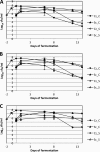Candida zemplinina can reduce acetic acid produced by Saccharomyces cerevisiae in sweet wine fermentations
- PMID: 22247148
- PMCID: PMC3298173
- DOI: 10.1128/AEM.06768-11
Candida zemplinina can reduce acetic acid produced by Saccharomyces cerevisiae in sweet wine fermentations
Abstract
In this study we investigated the possibility of using Candida zemplinina, as a partner of Saccharomyces cerevisiae, in mixed fermentations of must with a high sugar content, in order to reduce its acetic acid production. Thirty-five C. zemplinina strains, which were isolated from different geographic regions, were molecularly characterized, and their fermentation performances were determined. Five genetically different strains were selected for mixed fermentations with S. cerevisiae. Two types of inoculation were carried out: coinoculation and sequential inoculation. A balance between the two species was generally observed for the first 6 days, after which the levels of C. zemplinina started to decrease. Relevant differences were observed concerning the consumption of sugars, the ethanol and glycerol content, and acetic acid production, depending on which strain was used and which type of inoculation was performed. Sequential inoculation led to the reduction of about half of the acetic acid content compared to the pure S. cerevisiae fermentation, but the ethanol and glycerol amounts were also low. A coinoculation with selected combinations of S. cerevisiae and C. zemplinina resulted in a decrease of ~0.3 g of acetic acid/liter, while maintaining high ethanol and glycerol levels. This study demonstrates that mixed S. cerevisiae and C. zemplinina fermentation could be applied in sweet wine fermentation to reduce the production of acetic acid, connected to the S. cerevisiae osmotic stress response.
Figures



Similar articles
-
Exploitation of the non-Saccharomyces yeast Starmerella bacillaris (synonym Candida zemplinina) in wine fermentation: physiological and molecular characterizations.Int J Food Microbiol. 2015 Apr 16;199:33-40. doi: 10.1016/j.ijfoodmicro.2015.01.009. Epub 2015 Jan 17. Int J Food Microbiol. 2015. PMID: 25625909
-
Comparative evaluation of some oenological properties in wine strains of Candida stellata, Candida zemplinina, Saccharomyces uvarum and Saccharomyces cerevisiae.Food Microbiol. 2011 Feb;28(1):94-100. doi: 10.1016/j.fm.2010.08.011. Epub 2010 Sep 22. Food Microbiol. 2011. PMID: 21056780
-
Optimization of fermentation-relevant factors: A strategy to reduce ethanol in red wine by sequential culture of native yeasts.Int J Food Microbiol. 2019 Jan 16;289:40-48. doi: 10.1016/j.ijfoodmicro.2018.08.016. Epub 2018 Aug 18. Int J Food Microbiol. 2019. PMID: 30196180
-
Impact of mixed Torulaspora delbrueckii-Saccharomyces cerevisiae culture on high-sugar fermentation.Int J Food Microbiol. 2008 Mar 20;122(3):312-20. doi: 10.1016/j.ijfoodmicro.2007.12.023. Epub 2008 Jan 4. Int J Food Microbiol. 2008. PMID: 18262301
-
Acetic acid bacteria and the production and quality of wine vinegar.ScientificWorldJournal. 2014 Jan 21;2014:394671. doi: 10.1155/2014/394671. eCollection 2014. ScientificWorldJournal. 2014. PMID: 24574887 Free PMC article. Review.
Cited by
-
Effects of High Sugar Content on Fermentation Dynamics and Some Metabolites of Wine-Related Yeast Species Saccharomyces cerevisiae, S. uvarum and Starmerella bacillaris.Food Technol Biotechnol. 2020 Mar;58(1):76-83. doi: 10.17113/ftb.58.01.20.6461. Food Technol Biotechnol. 2020. PMID: 32684791 Free PMC article.
-
Effect of Saccharomyces cerevisiae and Candida zemplinina on quercetin, vitisin A and hydroxytyrosol contents in Sangiovese wines.World J Microbiol Biotechnol. 2015 Jul;31(7):1137-45. doi: 10.1007/s11274-015-1863-9. Epub 2015 May 5. World J Microbiol Biotechnol. 2015. PMID: 25940328
-
Multistarter from organic viticulture for red wine Montepulciano d'Abruzzo production.Front Microbiol. 2012 Apr 18;3:135. doi: 10.3389/fmicb.2012.00135. eCollection 2012. Front Microbiol. 2012. PMID: 22529841 Free PMC article.
-
Biocontrol activity of Starmerella bacillaris yeast against blue mold disease on apple fruit and its effect on cider fermentation.PLoS One. 2018 Sep 21;13(9):e0204350. doi: 10.1371/journal.pone.0204350. eCollection 2018. PLoS One. 2018. PMID: 30240411 Free PMC article.
-
Machine Learning Techniques Disclose the Combined Effect of Fermentation Conditions on Yeast Mixed-Culture Dynamics and Wine Quality.Microorganisms. 2022 Jan 5;10(1):107. doi: 10.3390/microorganisms10010107. Microorganisms. 2022. PMID: 35056556 Free PMC article.
References
-
- Andorrà I, et al. 2010. Effect of pure and mixed cultures of the main wine yeast species on grape must fermentations. Eur. Food Res. Technol. 231:215–224
-
- Bely M, Stoeckle P, Masneuf-Pomarède I, Dubourdieu D. 2008. Impact of mixed Torulaspora delbrueckii-Saccharomyces cerevisiae culture on high-sugar fermentation. Int. J. Food Microbiol. 122:312–320 - PubMed
-
- Brezna B, et al. 2010. Evaluation of fungal and yeast diversity in Slovakian wine-related microbial communities. Antonie Van Leeuwenhoek 98:519–529 - PubMed
-
- Ciani M, Beco L, Comitini F. 2006. Fermentation behavior and metabolic interactions of multistarter wine yeast fermentations. Int. J. Food Microbiol. 108:239–245 - PubMed
-
- Ciani M, Comitini F, Mannazzu I, Domizio P. 2010. Controlled mixed culture fermentation: a new prospective on the use of non-Saccharomyces yeasts in wine making. FEMS Yeast Res. 10:123–133 - PubMed
MeSH terms
Substances
LinkOut - more resources
Full Text Sources
Molecular Biology Databases

